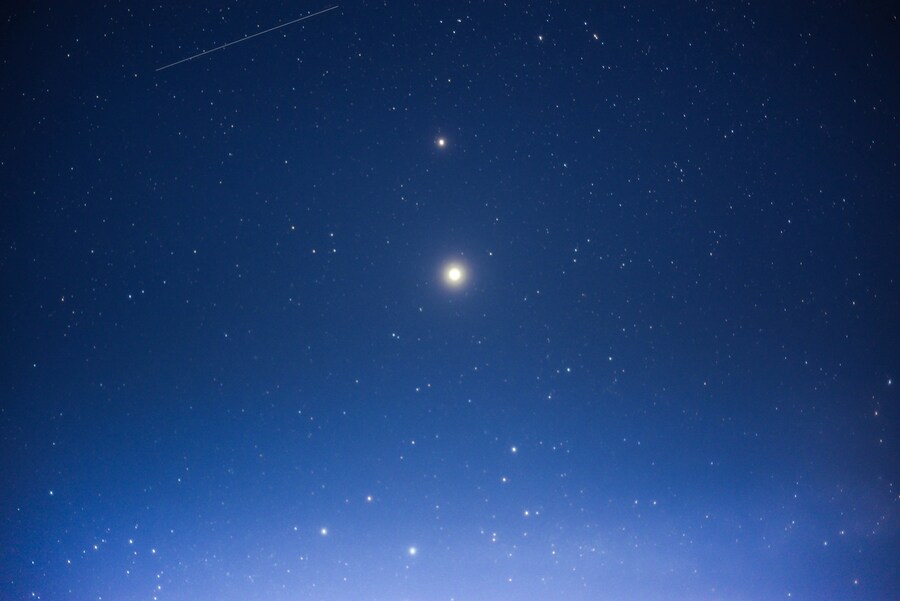A partially eclipsed supermoon is anticipated as well!
What celestial events await us in September?

Source: Hannah Domsic/Unsplash
September ushers in a flurry of captivating night-sky sights. From the potential for above-average northern lights, which tend to intensify around the equinoxes, to optimal planet viewing and the remarkable sight of a partially eclipsed supermoon, there's no shortage of celestial wonders to behold.
If you're planning to venture out for some sky-watching, keep in mind that dark-sky locations, such as stargazing-focused hotels, offer the best vantage points. You can bring your own pair of stargazing binoculars or choose an accommodation that provides a telescope, but many of the month's celestial events can be enjoyed with the naked eye.
This month, there are several can't-miss celestial events taking place at night that are worth keeping an eye on. Be sure to make a note of the specific locations and time frames to give yourself the best chance of enjoying these sights to the fullest. Let's dive right in!
Sept. 5: Mercury reaches greatest western elongation
On September 5th, our solar system's innermost planet, Mercury, will be more visible than usual. It'll reach its greatest western elongation, meaning it'll be at its farthest point from the sun, around 11 p.m. ET on September 4th, according to EarthSky. However, it won't be visible in the sky until the pre-dawn hours of September 5th, from around 5:45 to 6:15 a.m., as reported by SkySafari. You'll be able to spot it with the naked eye due to its -0.3 magnitude, which is roughly between the brightness of Sirius and Polaris. Look towards the eastern horizon, where you'll see Mercury alongside Mars, Jupiter, and Uranus in a diagonal row.
Sept. 7: Saturn at opposition
On the night of September 7th, Saturn and its magnificent rings will be on full display. The planet will reach opposition, meaning it'll lie opposite from the sun when viewed from Earth. As a result, it'll shine at its brightest magnitude (0.57) of the year. Look for a yellowish dot traveling above the east-southeast horizon in the constellation Aquarius after sunset. While you can see Saturn with the naked eye, using a backyard telescope will allow you to appreciate its captivating rings even more.

Source: Mishal Ibrahim/Unsplash
Sept. 17: partially eclipsed full Harvest Supermoon
If you missed the first supermoon of the year in August, you have another chance. The full Harvest Supermoon on the evening of September 17th – the second of four supermoons in 2024 – offers a special viewing opportunity. Stargazers across much of the world, including the United States (outside of Alaska), western Europe, parts of Asia, and Africa, will witness a partially eclipsed Harvest Supermoon around 10:45 PM Eastern Time, according to SkySafari. The lunar spectacle will begin around 8:41 PM Eastern Time as the moon enters Earth's light outer shadow, with the signature eclipse "bite" missing from 10:13 to 11:16 PM Eastern Time.
Sept. 20: Neptune at opposition
In addition to the captivating supermoon eclipse, this month presents an excellent opportunity to observe the planet Neptune. Through a backyard telescope or stargazing binoculars, you can catch one of the best views of Neptune for the year 2024. The distant planet will reach its closest point to Earth (opposition) on September 20th around 6:45 PM Eastern Time, according to Star Walk. It'll be visible throughout much of the night above the east-southeast horizon. Look for Saturn, visible to the naked eye, to the right of Neptune as well.

Source: Steve Gribble/Unsplash
Sept. 22: September equinox
On September 22nd, the sun will cross the celestial equator, marking the transition to autumn in the northern hemisphere and spring in the southern hemisphere. The equinoxes are known to produce particularly vibrant aurora displays, so it might be worth downloading a northern lights app to keep track of the likelihood of sightings in the contiguous United States. Alternatively, you could plan a trip to a prime northern lights viewing location in the days leading up to and following September 22nd. On this night, the moon will also approach the Pleiades star cluster, also known as the Seven Sisters, creating a dazzling end to the summer (or winter) season.
Sept. 22: Chicagohenge
You may have heard of Manhattanhenge, but did you know that Chicago's skyline has its own version of the solar alignment spectacle? On September 22nd, the sun will align perfectly with the Windy City's east-west-facing streets during both sunrise and sunset, which are scheduled for 6:45 a.m. and 7:02 p.m. local time, according to Secret Chicago. The organization recommends watching the event from Washington Street in Millennium Park or from E. Randolph Street between State Street and Michigan Avenue.
Make your trip a breeze: book convenient airport parking with ParkingNearAirports.io!

Source: Alina Kovalchuk/Unsplash
Don't let the logistics of your stargazing trip hold you back! Thankfully, off-site airport parking options are readily available through our smart booking platform – ParkingNearAirports.io. Find cheap Сhicago Airport parking with shuttle service and compare domestic airport parking charges that fit your budget. Enjoy a convenient and affordable parking solution while you explore the wonders of the night sky!






